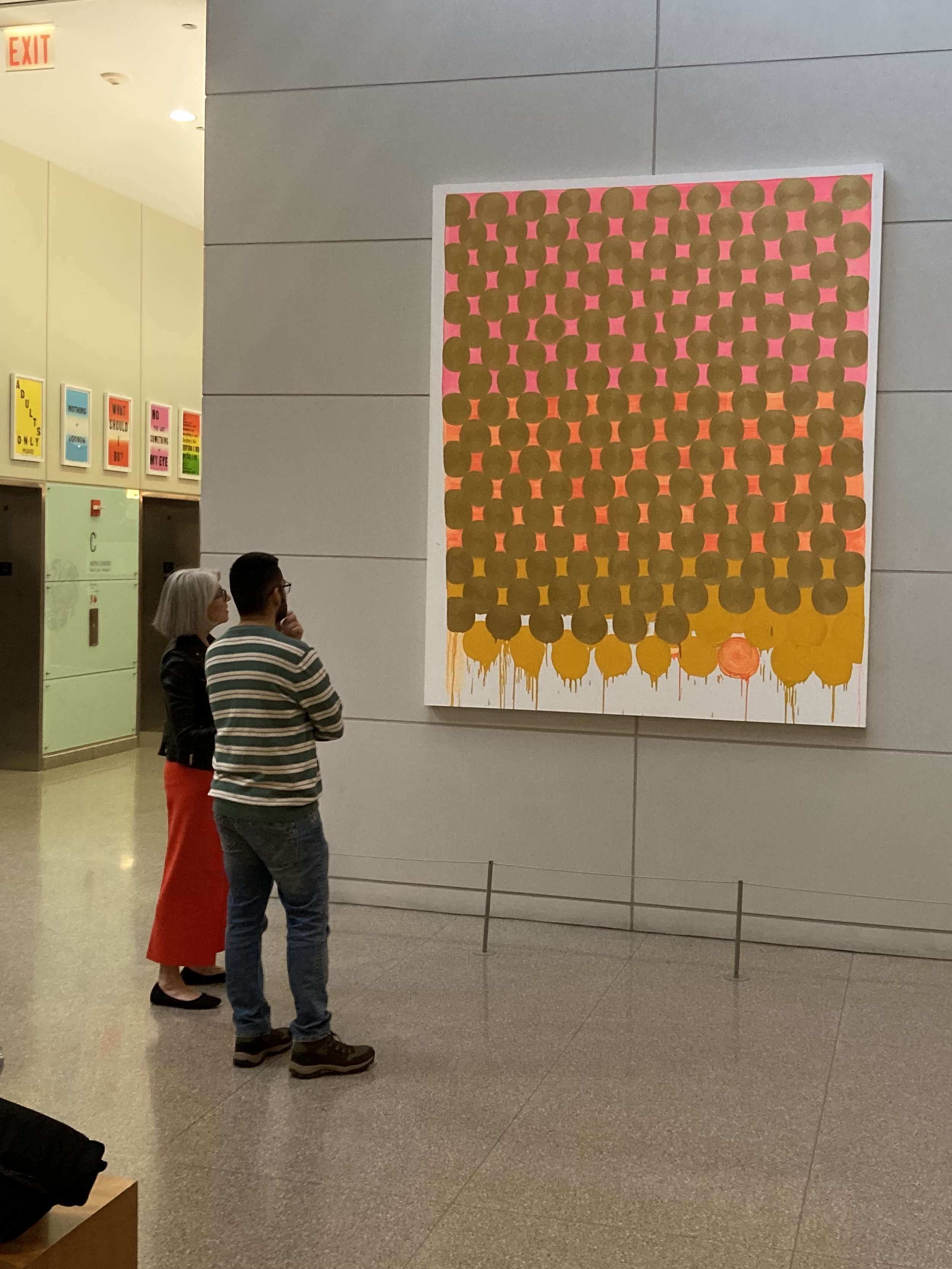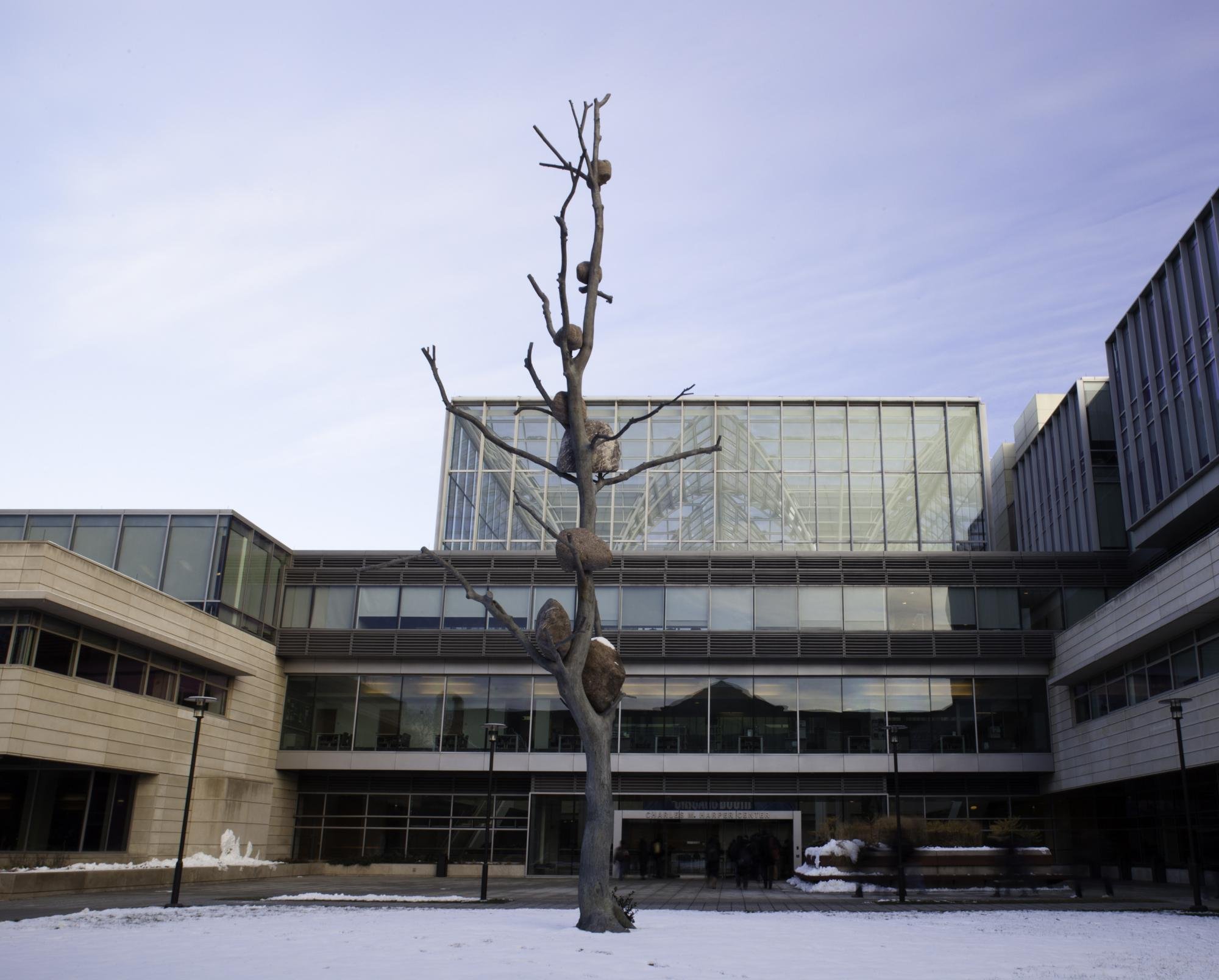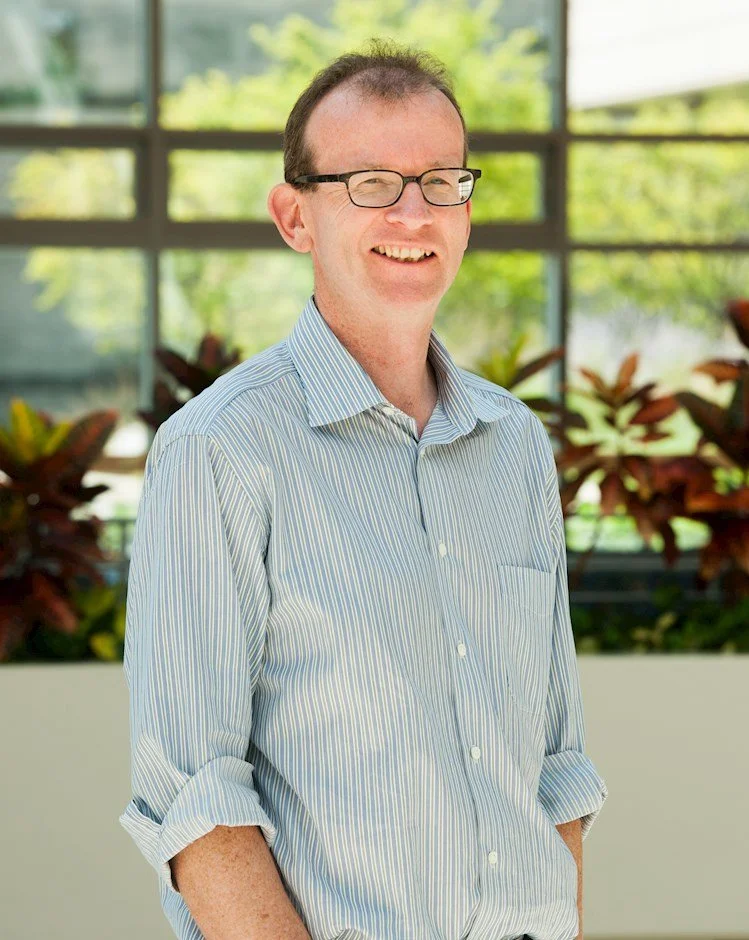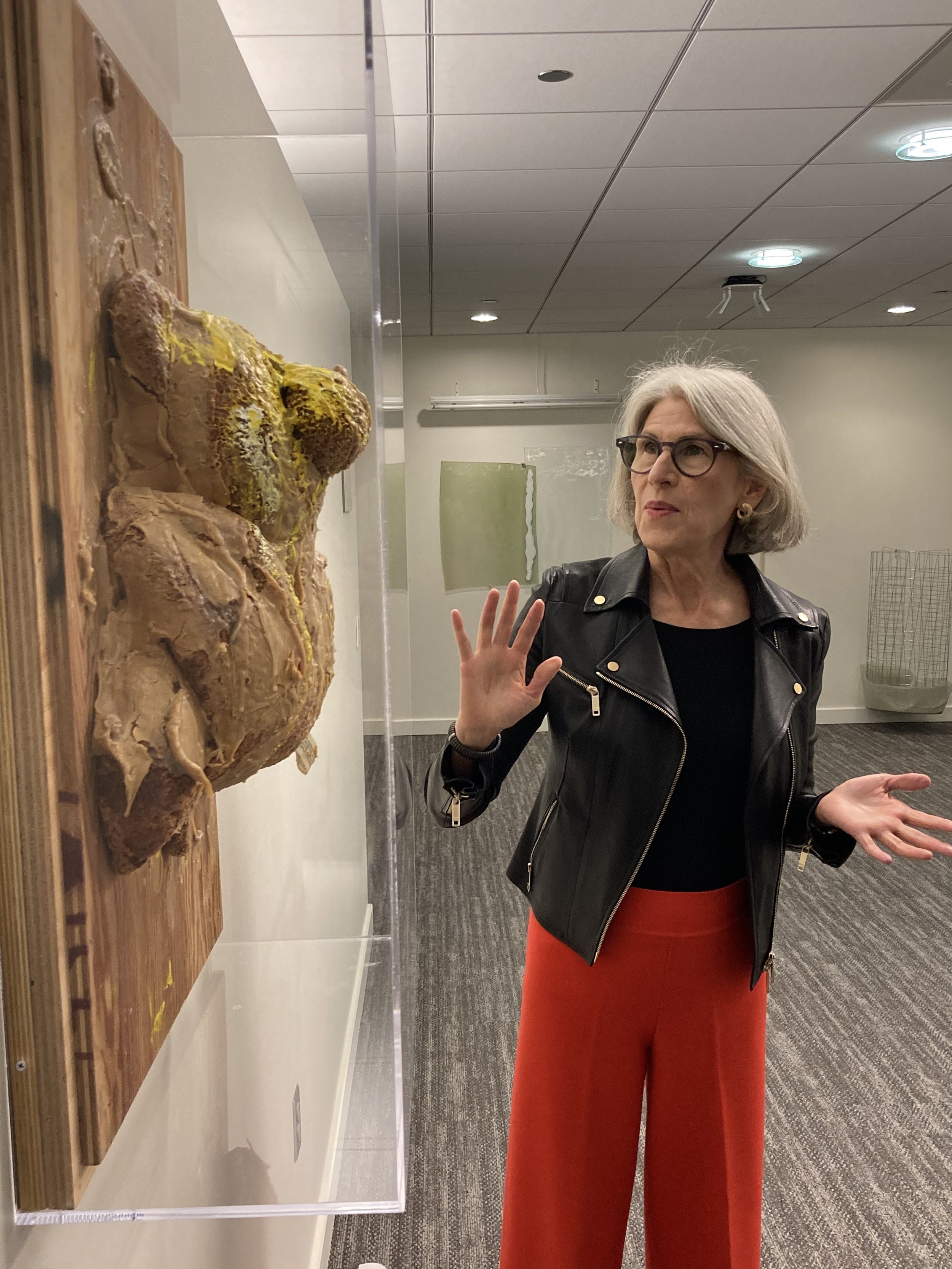“Everyone is welcome”: Booth School’s world-famous art collection
Mary Ittelson, Adjunct Assistant Professor of Strategy in the Booth School of Business, and Eshon Prashar, a first-year student at the Harris School of Public Policy, discuss Judy Ledgerwood’s Early Afternoon (Daylight Burning) in the Booth School’s Harper Center Concourse.
New acquisitions expand stunning art collection in the UChicago business school
by Ellen Wiese
“I’m going to show you a whole sequence of things that people now think of as art,” Canice Prendergast says to a group of staff, students, faculty, and arts appreciators in the lobby of the Harper Center. The regular tour led by the W. Allen Wallis Distinguished Service Professor of Economics is so well-attended that spots are raffled off, and with good reason—it’s a rare opportunity to explore the world-renowned art on display at the Booth School with the person perhaps most responsible for its presence in the building.
The collection, now 16 years old and composed of 800 pieces by almost 200 artists, occupies the whole of the five-story building, from the newly acquired canvas-and-pastel work by Naotaka Hiro outside faculty offices to Jeppe Hein’s classic neon sign in the heart of the building that reads, Why are you here and not somewhere else. The soaring Chicago home of the Booth School of Business is not necessarily where one would expect to find some of the best contemporary art from around the world—and yet, subtly and overtly, in classroom hallways and courtyards, that is exactly what this collection contains. Unique in both the space it occupies and the philosophy of its collecting, the art at the Harper Center has become a remarkable resource and renowned collection precisely because of its cross-pollination and interconnection with the Booth School.
Visitors to the art collection at the Harper Center are encouraged from 9am to 5pm daily.
After a pause during the lockdowns and cutbacks of the first years of the COVID-19 pandemic, Booth is unveiling several new acquisitions—all, as with the rest of the pieces on view throughout the building, freely available to the viewing public. These stunning works by artists including Lisa Alvarado, Jean Katambayi Mukendi, Edgar Calel, and Ulala Imai explore themes of lockdown, identity, and memory and continue to expand both the geographic and artistic scope of a unique and uniquely significant collection.
The art of a business school
Fifteen years ago, Prendergast was given the job of “putting something on the walls” of the new Booth building. As part of a five-member steering committee comprised of a mix of what he calls “enthusiastic amateurs” and art world professionals—James Rondeau, Suzanne Ghez, Suzanne Deal Booth, and Dean Valentine—Prendergast has utilized a designated segment of the capital endowment that built the Harper Center to create one of the best contemporary art collections in the country (you can learn more about the collection’s history here).
Ideas of Stone—fondly known as “the tree”—is a large-scale outdoor sculpture created by the Italian artist Giuseppe Penone in 2004, with eight granite rocks lodged in the branches that Penone carefully collected from a river near his home. This piece, located outside the Harper Center, is a celebrated item in the Booth Collection, and is also counted among UChicago’s collection of public art.
The Harper Center is a busy space, and that comes with its own set of constraints. There’s the question of keeping the work safe—from backpacks, routine maintenance and cleaning, and the general hustle and bustle of a workplace. Unlike traditional museums, almost none of the art at Harper is enclosed in plastic or glass, providing a more intimate experience but also greater risk of damage. There’s also the question of content—while Prendergast and the other curators don’t shy away from difficult subject matter, they are conscious of the fact that these are spaces students and faculty travel through every single day. But even with the challenges it poses, the living space is an extraordinary asset.
For many artists, when their work is purchased, especially by private collectors, it’s placed in storage to avoid damage or depreciation. “Nobody ever gets to see it,” says Prendergast. “It’s a real challenge for the art world. But what we do is we have it up all the time.” When Wolfgang Tillmans—widely regarded as the greatest photographer of his generation—visited the collection, Prendergast says, “he was ecstatic that thousands of people get to see his work every year.”
It’s not just the foot traffic that makes the Booth collection unique, but also the specific context of its presence in a business and economics school. While there is no strict theme—Prendergast and the other curators wanted to avoid limiting the collection’s scope—over the years certain trends have emerged. “If I look at my colleagues, most people work on things like education, trying to get sick people to take their drugs, food banks—we all use the tools of economics to think about things like that,” says Prendergast. Many contemporary artists are examining those same issues from a different perspective. “Most people in this building had no conception that artists are interested in things like how memory works, how inequality manifests itself, how identity affects our behavior, how culture affects people’s choices. They think about history, they think about memory, they think about globalization. There’s an enormous amount of common ground.” Current MBA candidate and Editor-In-Chief of Booth’s newspaper ChiBus Rishav Dhar agrees that the social bent of the artwork reinforces the scholarship of the Booth School. “People are always very aware of the social impact of their work—sustainability, social benefits, what is the larger impact of the work you’re doing,” he says. “With the art pieces that provoke strong reactions, it takes the art past the realm of the hypothetical. It is provoking real questions, and people are viewing it and thinking about it, specifically because of its location in the business school at this time.” The way the Harper Center is designed, Dhar adds, the route from every major entrance offers the chance to engage with some form of artwork (check out a recent ChiBus article for a tour of some of the highlights).
Artist and former Public Art Curator for Jersey City Meenakshi Dash (MBA ‘08) now works at the Booth School, but initially interacted with its art collection as an MBA student and then as an alumna. The social science orientation of the artworks and the way living with art impacts the scholarship and operation of the school is something she thinks is crucial. “The art is a nice reminder that we can change, we can innovate, we don’t have to take ourselves too seriously,” Dash says. “I like that it’s a bit challenging and disruptive.”
Every academic discipline relies on an element of abstraction, says Prendergast. Economists use a specialized language to convey something about the world, and the same goes for contemporary artists. “Just because we use such different languages doesn’t mean we’re not actually trying to say something similar,” he says. “What the collection has really made clear to me is how important it is for people to live with this every day. Because it’s only by being immersed in it that they eventually see that this language has some resonance with them.”
Canice Prendergast, the W. Allen Wallis Distinguished Service Professor of Economics, was charged with putting “something on the walls” of the Harper Center. His love of contemporary art and expertise in economic markets give him an especially interesting perspective on the collection.
Means of collection
Another of the constraints—and subsequent successes—of the collection is the manner in which it acquires artwork. Contemporary art, Prendergast says with a laugh, is a “really, really weird market.” Most of the money spent is spent on a tiny fraction of artists—and many of those spending the money are only looking for the clout of possessing a piece that others think is valuable. Collections tend to define this metric of value by the artists they acquire, but the Booth School is a comparatively small collection with a much smaller budget than most. In a market only growing more expensive, they need to be creative with their acquisitions. This means that Booth is looking for artists early in their careers, artists from areas outside traditional art scenes, and artists who have gone unrecognized by major galleries.
This strategy has met with significant success. Several artists whose early works are in the Booth collection are now displaying at Pace, a leading international gallery. These include Adam Pendleton and Marina Perez Simao, both on display on the fourth floor of the Harper Center; additional art by Perez Simao is among the Harper Center’s recent acquisitions. Similarly, works by artist Veronica Ryan, this year’s winner of the prestigious 2022 Turner Prize, were acquired by the Booth collection before she had any gallery representation (check out her work, including Booth’s recent acquisitions, on the third floor).
As a result of its unique parameters, the Booth collection has remained nimble, with a reputation for highlighting up-and-coming artists who go on to become major figures in the art world. Creators whose work would otherwise not be available outside large galleries and museums are on the wall here. “If you go to the Art Institute, and you go to the contemporary wing, there are two works they have on show by artists under the age of 45,” says Prendergast of artists Park McArthur and Cameron Rowland. “We have both of them in the collection, and we bought them much earlier than they did.”
While Prendergast emphasizes that this is not the intention of the collection, they’ve also been very successful in terms of the artworks’ value. He’s cagey about numbers, but estimates hold that the combined worth of the art on display has increased more than tenfold. “When we started out, nobody had a clue what the hell we were doing,” he says. “But now we have got to a point where we’re pretty much at the top of every queue.”
Professor Ittelson speaks about Trophy (Big Bear), by DoVA faculty member Pope L., which lives on the Harper Center’s third floor.
The case for living with art
Development of the collection was put on hold during the pandemic, but now, as restrictions ease on campus, the Booth School is welcoming its first new acquisitions in several years. While the mission is the same, “we did get a bit more adventurous,” says Prendergast. They’re incorporating a few computer-based works incorporating sound, including a piece by interdisciplinary artist Frances Stark. They’ve also taken the opportunity to continue to expand geographic diversity. “We’re always cognizant of that,” he says. “The American art world can be very parochial. I think we’ve been pretty good at trying to look in places that other people are not looking.” One of the recently acquired pieces, a long, horizontal landscape by Nohemi Perez, evokes the “panoramic painting” of sixteenth-century Spanish colonizers. Looking closely, present-day complexities of the border between Colombia and Venezuela like smuggling and paramilitary activity can be seen reflected in Perez’s jungle (find it newly installed in the concourse near room C07).
As people return to the Harper Center, the importance of an art collection in a living, accessible, everyday building has become increasingly clear. The collection is an asset to Booth students, but the opportunity it provides is not limited to just those who work and study in the school. Art is a public resource, Prendergast emphasizes, and the collection is meant to be seen by everyone who might be interested.
He has little patience for the relegation of works of art to only wealthy audiences and museum spaces, which contributes to what Prendergast calls the Eiffel Tower problem—“you go to France and you see the Eiffel Tower, and you think, ‘Oh, that’s nice,’ and then you forget about it.” Prendergast envisions the Booth School as an antidote to this sort of thinking: a functional space, with art not set behind glass or in storage but rather somewhere people walk past constantly. “I firmly believe in the view that art should live and people should see it,” Prendergast says. The purpose of the Booth collection is not to preserve the material in perfect condition for a hundred years from now—rather, it’s to contribute to the lives and scholarship of people now. “Change is happening all the time,” says Jess Hutchinson, Editorial Content Manager at the Logan Center for the Arts. “Even in just the time I’ve been sitting here, the next time I walk by the art, I’m not exactly the same. So my interaction with that art might be a little bit different.” This understanding of living art is predicated on a lively environment around the work, one that engages with it and incorporates it as part of everyday life—not something separate. “Every time you walk by a piece that adds color, vibrancy, or even text to a wall, there’s a question. It evokes curiosity,” says Dash. “Whether you follow up on that curiosity is entirely up to the observer. But it entices and it evokes that curiosity, which in a way for art is what you want to achieve.”
This model of collecting is not without risks, Prendergast acknowledges. But, in all the years of displaying the collection at Booth, there has been damage to just one piece—a work by Stephen G. Rhodes that was scratched by a backpack. A few years ago, Rhodes asked if he could come see the work installed. “I’m like, ‘Oh God, this thing is scratched,’” says Prendergast. When Rhodes saw the piece, he approached the professor and said, “Oh, it’s way better with the scratches!” (You can see this work and others by Rhodes on the third floor.)
A full catalog of the work on display is available on the new collection website, and there is discussion about building an interactive guide to the collection, but for now, the best way to experience the art on display is by exploring the Harper Center. There are no parameters to visiting, Prendergast emphasizes—the building operates on the same hours as other University spaces, and the public is permitted on all floors throughout the day. Everyone involved, from the faculty who work among the art to the artists themselves, want people to see and engage with the works. The art in the Harper Center has been collected to be lived with and shared as widely as possible, and that means that the doors are open—to classes, to art students, to practicing artists, and to anyone with an interest in the varying and remarkable contemporary works on display. “There’s nothing quite like seeing art in the flesh and truth,” says Prendergast. “We want to get across the message that everyone is welcome.”
The Booth School of Business campuses in London and Hong Kong also house pieces in the Booth School Collection. Click the buttons to explore.




